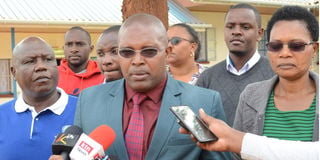Murang'a to enjoy lower-priced, sewage-sourced cooking gas

Muwasco Managing Director Daniel Ng'ang'a addressing the media in Murang'a on September 16, 2022. He announced the firm will start generating cheap cooking gas from sewerage deposits by February.
The Murang’a Water and Sanitation Company (Muwasco) is poised to provide Kenya with cheap domestically produced gas by February next year.
Muwasco and Murang'a University plan to recycle sewerage deposits to produce biogas at an estimated cost of Sh1.5 billion.
A 16-kg cylinder of the cooking gas is expected to retail for less than Sh600.
The university will also provide lab expertise to enhance the safety of water supplied to Muwasco's customers.
The partnership also includes planting 10 million trees in water catchment areas and cooperation with the county government to fight environmental degradation and land grabbing around water sources.
Liquefied petroleum
Muwasco Managing Director Daniel Ng’ang’a on Friday said the groundwork has started. He said reliance on liquefied petroleum gases (LPG) has exposed many families to negative environmental effects and erratic prices.
"We are going to establish a biogas plant at the Karii sewerage treatment area, located near Murang’a town from where we will extract clean cooking gas,” he said.
“It is all about green energies. The first beneficiaries of this project will be those in Murang'a County, but we will be philanthropic enough to extend the benefits for a gain to other counties."
This, he said, will address the issue of bad odours related to central sewerage system deposits and keep away marauding animals like hippos that love hiding in such unattended environments.

Murang'a University's dean of applied sciences Sylvania Opiyo. She said the university will develop a cooking gas generated from sewerage project.
The extracted gas, he added, will also help produce power for street lights in neighbourhoods adjacent to the planned plant.
The plan will produce about three kilowatts that will be placed on the grid and used for other functions like street lighting, free connections to nearby hospitals, especially to run maternity incubators, schools and markets, Mr Ng’ang’a said.
"Our finances will be a partnership pact between ourselves, the county government, donors and the national government research fund,” he said.
"We have several partnerships that will deal with the technical aspects of the project. We will sign partnership agreements and our own university will be at the centre of it.
“It is a project that we cannot afford not to actualise, since it has the potential of directly employing more than 500 people and in the long run providing livelihoods for more than 3,000 people."
The partnerships, he added, will translate to more revenues for Muwasco and accrued benefits for the county government in wealth creation and lowered health risks that strain medical budgets.
Sylvania Opiyo, dean of the Department of Pure and Applied Sciences at Murang’a University, said the school has the willingness and capacity to bring the project to fruition.
Global map
"This is one area where we have the opportunity to justify our existence in Murang'a and the global map at large,” she said.
“We want to be there when history is written on how Muwasco brought area people cheap, safe and reliable energies, enhanced water quality to fight waterborne diseases and connected some to free electricity."
She said the university will help fight deforestation, land grabbing and environmental degradation.
Mr Ng'ang'a said the collaborations sought will also reduce water losses from the current 25 per cent to below five per cent.





